Shetland Sheepdog History
by Terry Thistlethwaite
The Lilliputian Collie, the Peerie Dog (meaning "fairy"),
the Little Bear Dog, the Fairy Dog, the Toonie Dog (from the Norwegian "tun", meaning "farm"), and ultimately the
Shetland Collie are all names by which the
Shetland Sheepdog has, over the years, been known.
The Shetland Islands off of Scotland have a close
geographical proximity to Norway, and expectedly the history
of these islands is tied closely with a Celtic and a Norwegian influence as well. The Vikings came from Norway to Shetland during the eighth and ninth centuries and brought with them the small spitz dogs that would come to have their influence on a number of herding breeds. Their suitability to the small rocky and climatically foreboding islands of Shetland, with it's characteristically diminutive breeds of
livestock, along with their proclivity to take on all
manner of canine farm chores, endeared these dogs to
the Shetlanders right from the start.
During the mid nineteenth century, the tourist trade in
Shetland nearly brought about the demise of their little
herding dogs. In order to fill the pet trade demand for the
darling little tykes, Shetlanders would often interbreed them
with just about "anything small" and ended up with what was
basically a batch of mongrel looking types, often with no
herding instinct whatsoever. Desperate to retain the much
needed small working dog that was quickly disappearing
from the gene pool, the island farmers and herdsmen bred
their diminishing number of true spitz type dogs to the
working Collies coming into Shetland along with the sheep
being imported in the late eighteen hundreds.
In 1906, the Shetland Collie made his debut at the annual
Crufts Dog Show in England, a sure sign that the breed had
"arrived" as an established purebred. In 1908, in Lerwick,
Shetland, the Shetland Collie Club was founded. The
following year , 1909, a breed club was established in
Scotland, as well. The English Shetland Collie Club was
founded in 1914.
As is typical when a new breed comes on the scene,
established breeders of other "Collie" breeds were
uncomfortable with what they perceived as an intrusion into
their ranks, and objected to the little dog from Shetland
carrying the moniker of "Collie" as well. The breed name was thus changed to Shetland Sheepdog in 1914, and to this day both Collie and Shetland Sheepdog breeders will protest vehemently when an unindoctrinated observer of
the obvious unwittingly refers to the latter as a
"Miniature Collie".
The British Kennel Club recognized the breed in 1909, and
the American Kennel Club gave them breed status in 1914.
Of course, 1914 also marked the outbreak of World War One, and along with it came a serious setback in the breeding and importation of dogs. This had a significant effect on the Shetland Sheepdog breed, especially in the U.S., as it was only in fledgling status as a pure breed at the time. That fact accounts for the time span between the the AKC's acceptance of the breed, and the establishing of the
American Shetland Sheepdog Association,
which did not come until 1929.
Some of the prominent early U.S. breeders
and importers of Shetland Sheepdogs were:
Constance Hubbard of Astolat;
Jess and Donna Brownes of BrowneAcres ;
Mrs. Cleveland of Geronimo;
William W. Gallagher of Paige Hill;
Mr. and Mrs. A. R. Miller of Pixie Dell;
Betty Whelen of Pocono;
Evelyn Davis and Mary Van Wagenan of Sea Isle;
Tobi Ain Brace of Shelt-E-Ain;
Dorothy Allen Foster of Timberidge;
Katherine and Willis Nichols of Walnut Hall
The importing of Shetland Sheepdogs from the British Isles
was common among U.S. breeders and fanciers into the
1950's. While it was probably size considerations that
primarily brought about the initial decline in importation (the
British and international standard for the breed being an
ideal of 14.5 inches, while the American standard set a
range of 13 to 16 inches, with the larger dogs becoming the
more "acceptable" for show) 8British and American type has
also diverged considerably. Today's British Sheltie has more the appearance of the British Collie, and the American Sheltie has more the appearance of the American Collie than either breed has it's own counterpart "across the pond".
It is likely that the early popularity of the Collie breed in the
U.S. along with the "suburbanization" of the American family
starting midway thru the twentieth century, weighed heavily
in the popularization of the "lap sized Lassie"
Shetland Sheepdog as a family pet. By the 1980's, in fact,
the adoringly nick-named "Shelties" had made their way
into the top ten rankings in AKC registrations. Many families
and individuals who felt precluded by space from having the
larger Collies report being initially drawn to the
Shetland Sheepdog for their resemblance to the Collie, but
in a smaller package. Once owned by the breed, however,
they became fully smitten with the Sheltie joy de verve,
and the unique Sheltie personality. It is certainly not unusual to see admirers, fanciers, and breeders who possess and enjoy both breeds, both for their similarities in look, and for their uniqueness in character.
Shelties remain extremely popular today in the U.S., and
can typically be seen in the show and obedience ring, as
well as having a large presence in the agility ring. They
also excel in other popular venues such as herding
competitions (naturally!) flyball, tracking, Frisbee, and the
upcoming sport of freestyle or "canine dance". Known
for their high intelligence, easy trainability, and devotion
to their families, these little dogs from a tiny chain of islands
half a world away from where the Disney studios in 1973
showcased a beautiful representative in the presentation
The Little Shepherd Dog Of Catalina have certainly managed to make their mark on the outside world!
Resourced from The Shetland Sheepdog and Shelties
articles by Iris Combe & Pat Hutchinson
Sheltie Talk, by Betty Jo McKinney and Barbara Reiseberg
The Shetland Sheepdog, by Margaret Osborne
The New Shetland Sheepdog by Maxwell Riddle
The New Complete Shetland Sheepdog by Maxwell Riddle
American Kennel Club records,
American Shetland Sheepdog Association records,
IMDB Database; "Disneyland" (on line)

Chestnut Rainbow, sired by Tweed,
was born in the early 1920's,
and is behind all of the U.S.,
and many British Shetland Sheepdogs today.
(bred and owned by Mr. G. B. Caird)
Ch Wee Laird Of Downfield a great grandson
of Chestnut Rainbow, is considered
to be the most influential sire in
U.S. Shetland Sheepdog pedigrees.
He is behind both Ch Banchory High Born ROM
and Ch Halstor's Peter Pumpkin ROM.
He was born in 1929
(bred by Mrs. J. C. Ramsay,
owned by Mrs. W. F. Dreer)
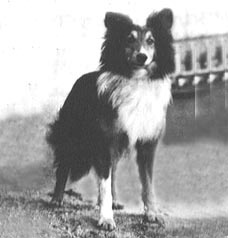
Ch Timberidge Temptation ROM, a great
grandson of Ch Wee Laird Of Downfield,
was Best Of Breed at the
ASSA National Specialty Show in 1944,
and again in 1946.
He is the first Shetland Sheepdog
to hold the title of Registry Of Merit (ROM)
and is believed to be in all U.S. pedigrees today.
(bred and owned by Dorothy Foster)
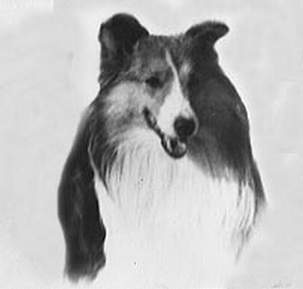
Ch Banchory High Born ROM was born in 1968.
He won the ASSA National in 1970,
and sired 82 champions in his lifetime.
He figures prominently in U.S. pedigrees today.
He was the great grandson of
Ch Shelt-E-Ain Reflection O'Knight
who was himself a great grandson of
Ch Timberidge Temptation ROM
(bred by Rosemary Shrauger, owned by Donna Olson)
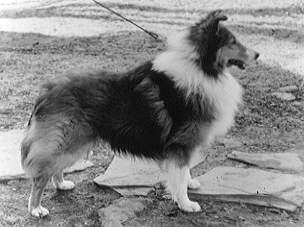
Am/Can Ch Nashcrest Golden Note ROM
was born in 1951. He won eight Working Groups
and over a hundred best of breeds.
He also won the ASSA National Specialty
show in 1954. He sired 26 champions
and figures prominently in U.S. pedigrees today.
His mother was Nashcrest Rhythm,
a granddaughter of Ch Timberage Temptation.
(bred by Edith Nash Hellerman owned by Evelyn Davis)
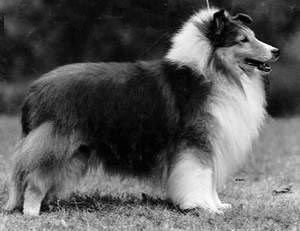
Ch Halstor's Peter Pumpkin won the
ASSA National Specialty in 1968 and 1974,
had over a hundred Best of Breed wins,
three all-breed Best in Shows wins,
and more than forty group placements.
Peter sired one hundred sixty champions,
and was at one time
the all time top producing sire for all breeds.
His mom was Ch Sea Isle Rhapsody of Halstor
a granddaughter of
Am/Can Ch Nashcrest Golden Note ROM
He is a prominent figure behind
U.S. Sheltie pedigrees today.
(bred by Edith Overly, owned by Tom Coen)
The Shetland Collie Standard
from the breed club in Lerwick, Shetland, 1909
Skull: Nearly as possible flat, moderately wide between the ears, and gradually tapering toward the eyes. There should only be a slight depression at the stop. The cheeks should not be full or prominent.
Muzzle: Of fair length, tapering to the nose, and should not show weakness, nor be snippy or lippy. The nose must be black, whatever colour the dog may be.
Teeth: Sound and nearly as possible level. Very slight unevenness is permissable.
Jaws: Clean cut and powerful.
Eyes: Of medium size, set somewhat obliquely, close together and of almond shape and of brown colour; full of intellegence and expression
Ears: Small and moderately wide at the base, and placed close together on top of skull. When in repose, they should be thrown back, but when on the alert brought forward and carried semi-erect, with the tips drooping forward.
Neck: Of fair length, somewhat arched, and of proportion to the body.
Body: Moderately long and level with well sprung
ribs and strong loins; chest deep.
Forelegs: Straight and muscular, and with a fair amount of bone.
Hind Legs: Muscular at the thighs, with well bent hocks.
Feet: Oval in shape, soles well padded. Toes arched
and close together.
Tail: Moderately long with abundant hair, carried low when the dog is quiet, with a slight upward swirl at the end, but gaily carried when the dog is excited, but not over the back.
Coat: Must be double. The outer coat consists of hard hair.
The undercoat, which resembles fur, is short, soft, and close.
The mane and frill should be abundant, the mask or face
smooth, as also the tips of the ears. The forelegs well
feathered. The hind legs above the hocks profousely
covered with hair, but below the hocks fairly smooth.
Colour: Any colour except brindle is permissable.
General Appearance: That of the Scotch Collie in miniature. (Collie character and type must also be adhered to.) Height must not exceed 38 cm [15"] at maturity,
which is fixed at ten months of age.
Faults: Short nose, domed skull, large drooping ears, weak
jaws, snippy muzzle, full or light eyes, crooked forelegs,
cow hocks, tail carried over the back, undershot or overshot
mouth.
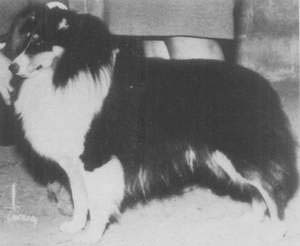
You're listening to
"Winyadepia"
(Shetland folksong)